Average position always left us wanting more.
But us advertisers had no choice. We had to use the metric for years.
Telling our bosses and clients that we think we’re showing up first.
We never had the transparency to know where our ads were truly showing up. Above search results? Under them? On the second page? We never knew the whole picture.
Then, Google delivered.
In 2019 they announced that they were sunsetting Average Position and totally redeemed themselves by adding brand new definitions and metrics.
They started by creating a name and definition for the ads that show above organic results called “top” and “absolute top.” As the cherry on top they added impression rate and impression share metrics that give crystal clear visibility into the location of your ads AND insight on opportunities to bid for a better location. Way more on this later.
In the post you’ll learn everything you need to know about ad positions so that you can understand why this change in average position was such a big deal. You’ll also get the intel on which metrics to track now and how to use them so that you can not only tell where your ads are showing up, but how to get them placed even higher. Armed with that info AND seven (debunked) myths, you’ll be an ad position expert.
Get brand new Google ad strategies straight to your inbox every week. 23,739 people already are!
What is Google ad position?
First, what ad position is not.
With Google Ads, ad position is not the location of an ad. Just because an ad has a position of one, does not mean it’s showing up in the prime tippity top spot of SERP (search engine results page).
Ad position refers to the order in which Google Ads show as compared to other ads. So if your ad has a position of one, it means that it is showing first before any other Google Ads. Unfortunately, that first place spot could still mean that it’s under organic search results.
How is Google ad position determined?
The position of your Google Ad is determined by a formula known as Ad Rank. Ad Rank is calculated by six main factors:
1. Your bid
When you set a bid it tells Google Ads the maximum amount you’re willing to pay for a click on your ad. There’s a multitude of ways to bid for your ads, depending on what your end goal is. Most advertisers focus on clicks, impressions, conversions, or views (for video ads).
Google runs an auction every single time it has ad space available on a website or search result. Then the auction decides which ads will show at that moment in that space. Your bid puts you in the auction.
2. Quality Score
The second part of determining ad position is quality score.
Quality score can be broken down into three key factors: ad relevance, landing page experience and expected click-through rate (CTR).
Google grades each component as either “Below average,” “Average,” or “Above average” as compared to other ads that showed for the exact same keywords in the last 90 days. Clearly, we like to push Above average.
Ad Relevance
Put simply, ads must pertain to the keyword(s) an ad is targeting.
However, some keywords will match a user’s exact search terms more closely than others. The closer the match, the higher the relevance. The higher the relevance, the higher your ad position.
Relevance matters for your landing page too.
Landing Page Experience
The landing page experience is a measurement of how relevant and useful your landing page is once a visitor clicks on your ad. Landing pages with higher ratings are usually well organized and have text that relates to a person's search terms.
For this reason, it’s important to make sure your landing pages are clear, user-friendly, and following best practices.
Expected click-through rate (CTR)
Google keeps tabs on the likelihood that your ad will be clicked when shown.
Google Ads takes into account how well your keyword has performed in the past, based on your ad's position, and assigns a prediction as to whether your keyword is likely to lead to a click on your ads. They call this the expected click-through rate.
Keep in mind that it doesn’t take into account your ad's position, extensions, and other ad formats that may affect the prominence and visibility of your ads. It’s only an estimate based on the assumption that the search term will match that keyword exactly.
When someone's search terms triggers one of your ads, Google Ads calculates a more accurate expected CTR based on the search terms, type of device, and other auction-time factors
Expected CTR is not to be confused with click-through rate which is an actual historic metric based on the ratio of how many people saw the ad to how many people clicked it.
By mastering ad relevance, landing page experience, and expected CTR you can improve your Quality Score. In turn, you’ll be able to improve your average position without ever having to reach into your pockets and increase your bid.
3. Ad Rank thresholds
The Ad Rank threshold is a minimum price, or reserve price, that an ad must achieve to show. It is dynamically determined at the time of auction and differs from keyword to keyword.
While it might not be inherently clear how these thresholds can impact ad position, it’s essentially Google making sure that they’re not giving away ads for free and that the barrier to entry is equal to the opportunity.
If your bid doesn’t meet the ad rank threshold, it will not show.
4. Auction competitiveness
The amount of competition you have for a keyword will directly affect your Ad Rank. If you’re neck and neck with another ad because every other Ad Rank factor in this list is equal, it’s going to come down to money.
As a higher-ranking ad gains a lead, they’ll also have to pay a higher cost per click (CPC) for the increased certainty of winning that higher spot.
5. Context of a person’s search
Google looks at the big picture to give the user the best experience possible. In addition to search terms, Google takes note of the searcher’s location, device, the time, the nature of the search terms, and even what other search results appear on the page.
For example, if you’re going after “mobile flat tire repair near me,” you better make sure your landing page has a great mobile view. In that context, most users would be searching those terms on their phone and Google could decide your ad isn’t the best to show if there’s no mobile-friendly version.
Let’s see it in action.
Here’s the first two ads that show when I search “mobile flat tire repair near me” on desktop vs mobile:
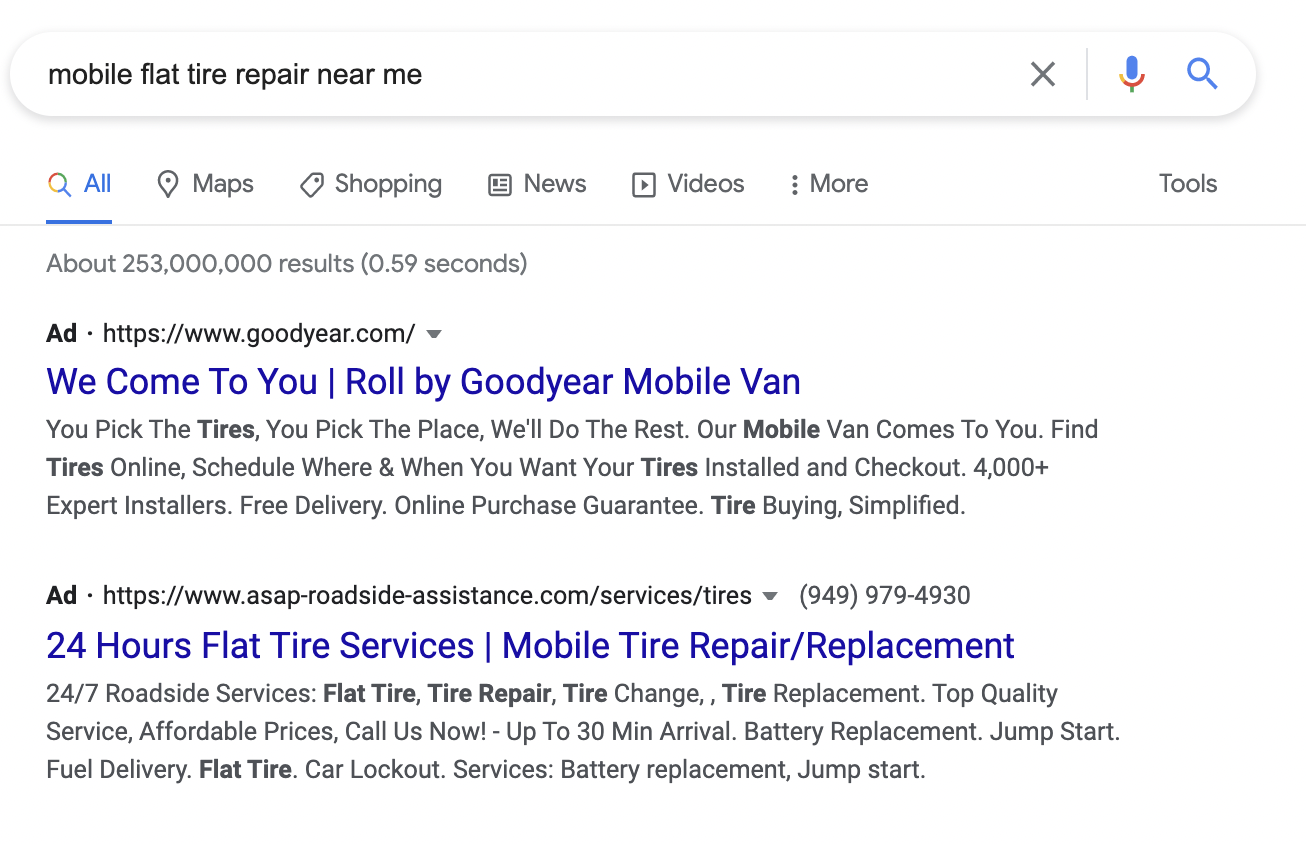
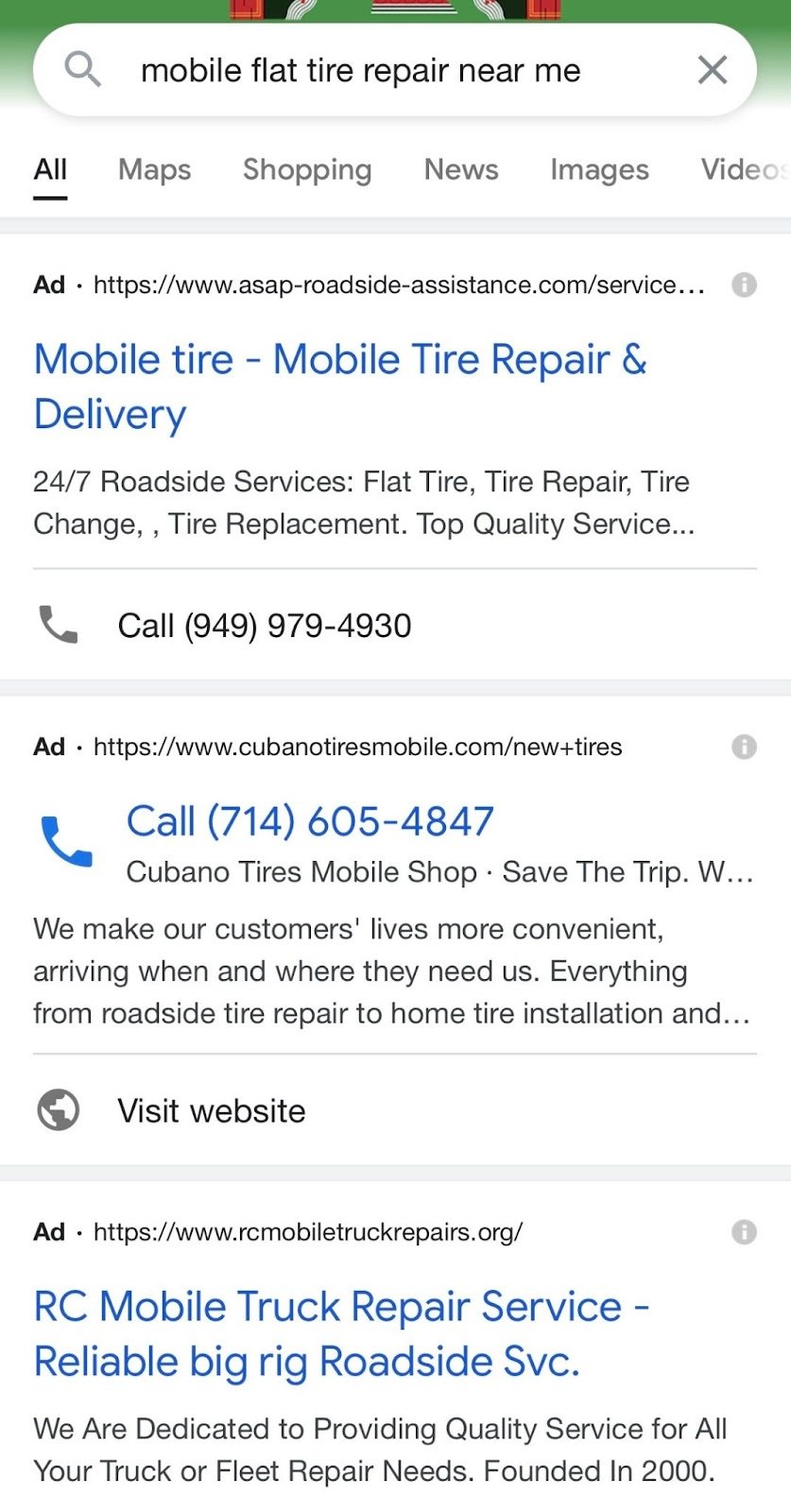
If you compare results, you see that while an ad from Goodyear shows up in spot one on desktop, it doesn’t show on mobile. ASAP Roadside Assistance shows on both!
Knowing that the context of the search matters, this all makes sense once you compare the mobile landing pages.
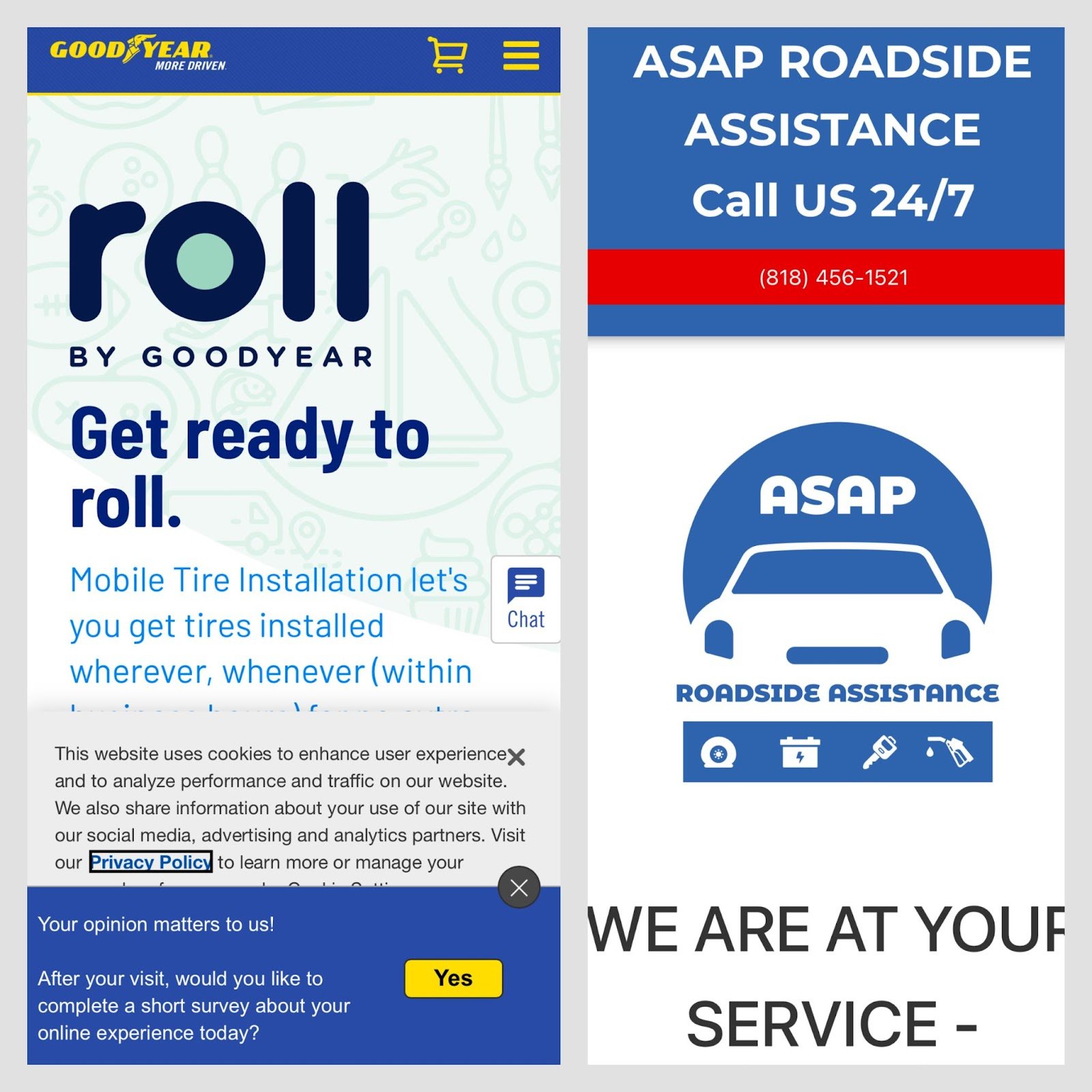
The landing page for ASAP Roadside Assistance is optimized for both mobile and desktop. It follows all landing page best practices and is really easy to navigate. If you’re stranded on the side of the road, it makes it really easy to get help in a single click.
While Goodyear’s full landing page isn’t bad, it’s advertising a tire replacement service built more for people looking for convenience versus being in a rush because of a flat. I had to read through both full landing pages myself to figure that out, but Google is freakin’ smart.
Google knows that if I’m searching for flat tire repair near me on my phone, there’s a good chance that I need help and I need it fast.
6. Expected impact of ad extensions and other formats
Ad extensions is a feature that shows extra business information with your ad, like an address, phone number, store rating, or more webpage links.
Let’s stick with the “mobile flat tire repair near me” for this one. If you’re searching for flat tire repair on your phone, you want to figure out who can get there the fastest and how much it’s going to cost. You’re not going to peruse a website or fill out a contact form, you’re going to hop on the phone because you need answers quickly.
If you look at the mobile search results from the “mobile flat tire repair near me” search above, you’ll notice that they all have a call extension. Google recognizes the use case and will increase the Ad Rank score of the ads that have a phone number extension.
To close out the discussion on how ad position is determined, even if your competition bids more than you, you can still win a higher position—at a lower price—with highly relevant keywords and ads.
Your Ad Rank is recalculated each time your ad is eligible to appear, so your ad position can fluctuate each time depending on the context of the person's search and the competition among other advertisers at the precise moment of the person's search.
What was Google Ads average position?
Average position was a metric that described how your ad ranked against other ads on SERP. It took the average position of every time your ad was shown. So if your ad was shown twice, once in the number “1” spot and once in the number “3” spot, your average position was “2.”
Why did Google Ads get rid of average position?
In short, it stunk.
The goal of the metric was to help advertisers get a sense of how prominently their ad was showing on SERP. But the average position metric was not even close to helpful for two main reasons
- While it showed an ad position, it didn’t indicate how many times that position was above organic search results. It was only relative to competition versus the actual position on the page.
- It was only an average. So if your ad showed three times, once in position “1” and twice in position “7,” your avg position would have been “5.”
Despite all this, the average position was a big deal. Many advertisers used the metric as one indicator of the success of their ads. Google couldn’t just let it die, in 2019 they replaced it with something much better.
What replaced average position?
Top and absolute top metrics
Google came up with what they call the “Top” and “Absolute Top.” These new metrics give you a much clearer view of the prominence of your ad on a page. Most importantly, they mean ads that show up above the organic results on the SERP.
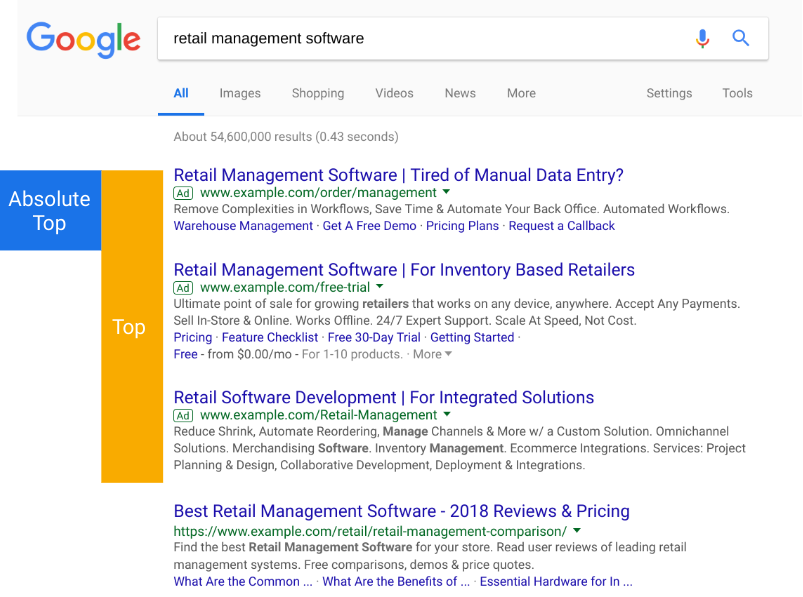
Absolute Top of the page means that it is the first ad above organic search results.
Top of the page means that it is in one of the top ads above organic search results.
With those two terms, comes new metrics that help give more insight on the location of your ads as well as how your bid can improve the location.
Metrics that help show location
- Search absolute top impression rate - The percentage of your ads that were in the Absolute Top
- Search top impression rate - The percentage of your ads that were in the Absolute Top
Both metrics can be found at the keyword, ad group, and campaign level. Unlike average position, these metrics don’t reflect the order of your ads compared to other ads, but the actual location of your ads on SERP.
Metrics that help show bid opportunity for improved location
- Search absolute top impression share - The impressions you’ve received in the absolute top location divided by the estimated number of impressions you were eligible to receive in the top location
- Search top impression share - The impressions you’ve received in the top compared to the estimated number of impressions you were eligible to receive in the top location
Impression share metrics are helpful when you want to understand the possibility for your ads to reach the top. If you want to optimize for position, these are the best metrics to use.
Now that you understand all there is to know about how Google determines ad position and how to measure it, you’re ready to start optimization on all your campaigns for the top. But first, make sure you’re not falling for any classic ad position myths.
7 common myths about Google Ad Position
Ad position is often misunderstood. Some claim that it’s one of the most important PPC metrics that you should be tracking.
I wouldn’t go as far as to say that it should be your golden egg. But I agree that it’s an important means to an end.
After all, ad position can determine how much and what kind of traffic you’ll receive. More than anything else, that will determine whether or not this PPC thing makes you money and works for you.
Yes, we should be tracking our ad position, but the trick is analyzing and acting on the data effectively.
I can’t stress how important it is to choose the advice you take wisely.
Now, let’s go ahead and break down some of the most common misconceptions about ad position:
Myth #1: The higher the position, the better results
This is a tricky one. On the one hand, yeah, it would make sense.
But believe it or not, a higher ad position doesn’t automatically mean you’re going to get better results.
A higher position could lead to more impressions and more clicks, but unless that’s from your target audience, your conversions won’t budge.
Ad position isn’t the only KPI. If you’re doing things right, all KPIs should rise in unison.
Here’s an example. Let’s say you’re advertising luxury pajamas made of high quality silk targeting the keyword “pajamas” and your ad is sitting in the number 1 position. Impressions soar, clicks take off.
Then your bounce rate starts to get worse (and that will eventually make your ad position slowly fall too). A lot of your visitors might not be able to afford the price tag that comes with luxury pajamas. They see the high price tag and dip right away. So what good is that ad position doing?
One solution to this dilemma is stating some of the qualifications you need in the ad copy in order to filter out the bad traffic. By adding a starting price to your copy, you don’t be wasting clicks on unwanted traffic, bringing your results back into equilibrium and keeping your ad position.
Myth #2: If I bid higher, I’ll surely improve my position
If there’s one trend that we’re quickly learning from this post, it’s that higher is not always better. A higher bid will not assure you a better position.
It may seem from time to time that Google is a big, bad, greedy money sucker that only cares about their profits. While this might not be wrong, they do have a standard of quality to maintain. In fact, they even contract over 10,000 search quality raters to double-check their performance.
It wouldn’t make sense for Google to simply allow the advertiser with the deepest pockets to own their search results. Due to this, Google stresses the importance of ad quality and, therefore, the role quality score plays in ad rank.
Myth #3: Google controls the world and we’re helpless, so who cares?
Ok, this one is kind of true. But only kind of.
Perhaps the one most important thing that I’ve learned in the digital marketing world is that they’re always watching us.
The amount of information that Google knows about us can be quite terrifying. Instead of running away, however, I’ve learned to embrace it.
The reason that Google wants to know so much about us is because they truly want to provide us with the best product possible. A product so high in quality and accuracy that it’s as if it was customized exactly for each of us.
So, instead of raising up our arms in defeat, us marketers can structure our advertising campaigns to take advantage of the targeting Google Ads allows. In return, we may find that our average positions will get a boost without the extra buck.
Myth #4: It’s too expensive to compete for top positions with the big brands
This myth is a bit of a culmination of the other myths we just discussed. If you’re a small ma & pa shop competing against Fortune 500s then, yes, it may be a bit challenging to compete; however, don’t give up.
If you choose the right keywords and devise a sound structure in your account, you could be the underdog feel-good story of the season.
Remember, QUALITY MATTERS and money isn’t involved in every Ad Rank factor.
Myth #5: If you’re not in the top three, you don’t exist
There’s a common joke among internet marketers —
Question: “What’s the best place to hide a dead body?”
Answer: “On page two of Google’s search results.”
Now, there are some pretty cool benefits to being in the top positions. For one, you appear before the organic listings and above the page fold, meaning you’ll definitely have many more eyes on your ad.
Two, the likelihood of extensions appearing with your ad increases. And three, your ad can appear longer and probably won’t be as truncated.
All those benefits definitely sound very attractive — but once again, it’s all about KPIs. Yes, being on page two of the search results can dramatically decrease your reach, but you can still survive and even thrive without reaching the top three search results.
Myth #6: Our competitors rank higher than us, so we need their magic
If all your competitors jumped off a bridge, would you?
It’s very important to understand your competitive landscape. Unless you have direct access to your competition’s Google Ads accounts or somehow have a mole planted on their side, you won’t really know if what they’re doing is successful or not. It’s much more important to have a firm grip on your own KPI goals and to know what your plan of attack is to achieve them.
With that said, Google does provide auction insights for comparing performance against competitors for a particular keyword or traffic source.
This allows you to see how you’re competing and make strategic decisions about additional opportunities. And if you notice a spike in CPC or a dip in position, your auction insights are a good first place to check.
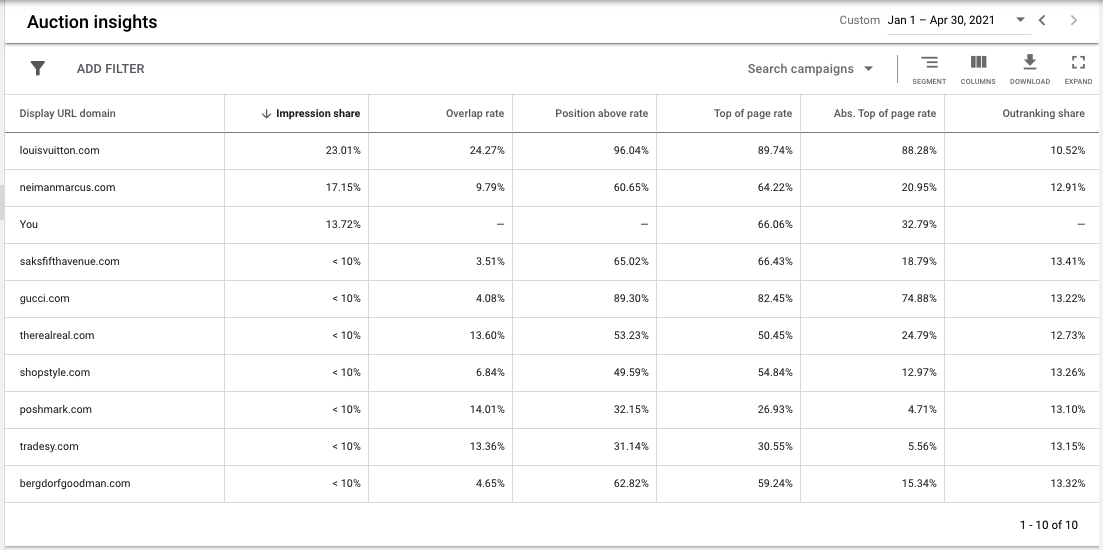
Myth #7: Let’s just throw the keyword all over the landing page
In the old days of digital marketing, “savvy advertisers” would hide text all over the landing page. This was an attempt to trick the search engine into thinking their landing page was the most relevant of them all.
This worked for a while. But you can only fool Google for so long before they catch on to you. I’m sorry to inform all you shortcut seekers out there, but today this tactic is obsolete.
It’s more important than ever to create quality landing pages that will convert. Google cares about quality and rewards us for doing the same.
Therefore, a proper landing page message match goes far beyond throwing your keyword all over the page.
Best Practices to Manage Ad Position
We’re almost there. But before we part ways, since you’ve been a great audience, we want to leave you with some of our very own KB best practices for managing average position.
Top vs. Other
While it definitely is more convenient to simply trust the ad position metrics in your Google Ads reporting, the top vs. other segments will paint a picture that should help you get to your ideal position faster.
Found under the the Segments tab, this hidden metric compares how your ads perform when shown in the top position versus other placements.
Bid Strategies
Worried about robots taking your job?
This might be a reality we need to prepare for. But in the meantime, while we still have our jobs, let’s use these robots to make our jobs a bit easier.
Automated bidding allows us to take some of the guesswork out of bid management.
Of course, there are some restrictions and best practices that are advised to use when utilizing automated bidding. However, as a general rule, it should be aligned with your own KPIs (ROAS, CPA, etc.).
For our purposes, use the target search page location bidding strategy once you determine which location is most effective for performance. This portfolio bid strategy can be used across multiple campaigns, ad groups, and keywords to target the top of the page or on the first page of Google search results.
After using the top vs. other segment to find where your performance is kicking bootay, using this bidding strategy can help you get to where you want to be.
SKAGs (Single Keyword Ad Groups)
Oh SKAGs, how we love thee.
There’s one fundamental reason SKAGs help us get great results for our clients. They allow us to granulate accounts to the point where we have complete control over performance.
By understanding the Iceberg Effect, we know that what we see above the surface can be much different from what lies beneath.
With SKAGs, we remove the search terms from “beneath” and target them as their own keywords. This enables us to appropriately bid for effective positions with fewer surprises.
Final thoughts on average position
With new metrics comes great responsibility.
The sunsetting of average position to make way for the addition of impression rate and impression share in the top and absolute top gives us more to keep track of. The benefit is that it also gives us more data to optimize our Google Ads game.
Position metrics are only one of many data points we’re using to improve ads.
Now that you understand the many factors that can help boost your ad positioning, we have all sorts of other secrets to get better results from your Google Ads:
- 7 Monstrous Ways To Improve Your AdWords Performance
- 12 Best Google Ads Bidding Strategies To Win in 2021
- Google Ads Audit:The Ultimate 91-Point Guide For Success
Let us know in the comments which secrets help your results and how high you can get your ads rank!